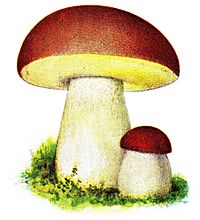Boletus facts for kids
Quick facts for kids Boletus |
|
|---|---|
 |
|
| Boletus edulis | |
| Scientific classification | |
| Kingdom: | |
| Division: | |
| Class: | |
| Order: |
Boletales
|
| Family: |
Boletaceae
|
| Genus: |
Boletus
|
| Type species | |
| Boletus edulis Bull. (1782)
|
|
| Diversity | |
| over 100 species | |
Boletus is a genus of mushroom. It has over 100 species. Many types are popular to eat. You can find them in places like Europe, Asia, and South America.
Contents
What Are Boletus Mushrooms?
Boletus mushrooms are a special group of fungi. They are known for their thick stems. They also have a unique cap. Instead of gills, they have tiny pores underneath. These pores look like a sponge.
Where Do Boletus Grow?
Most Boletus mushrooms grow on the ground. They often grow in forests. They like to be near certain trees. These trees include pine, oak, and birch. The mushrooms and trees help each other grow. This is called a symbiotic relationship.
How Do They Help Trees?
The mushrooms' roots connect with the tree roots. The mushrooms help the trees get water and nutrients. In return, the trees give the mushrooms sugars. This partnership is very important for both.
Famous Boletus Species
One of the most famous Boletus mushrooms is Boletus edulis. It is also known as the Porcini mushroom. People love to eat Porcini mushrooms. They have a rich, nutty flavor.
Porcini Mushrooms
Porcini mushrooms are highly valued. They are often used in cooking. You can find them fresh in autumn. Many people also dry them. Dried Porcini mushrooms have a very strong flavor. They are used in pasta dishes and soups.
Other Edible Boletus
Many other Boletus species are also good to eat. However, some are not. A few types can even make you sick. It is very important to know which mushrooms are safe. Always be sure before you eat any wild mushroom.
Identifying Boletus Mushrooms
Identifying Boletus mushrooms can be tricky. They have a fleshy cap. The underside has a spongy layer of tubes. These tubes contain the mushroom's spores. The stem is usually thick. It can sometimes have a net-like pattern.
Color Changes
Some Boletus mushrooms change color when cut or bruised. Their flesh might turn blue. This is a natural reaction. It does not mean the mushroom is bad. But it can help you identify the species.
Safety Tips
Never eat a mushroom you are unsure about. Always go with an expert. Or use a reliable field guide. This will help you stay safe. It is important to learn about mushrooms before picking them.
See also
 In Spanish: Boletus para niños
In Spanish: Boletus para niños

